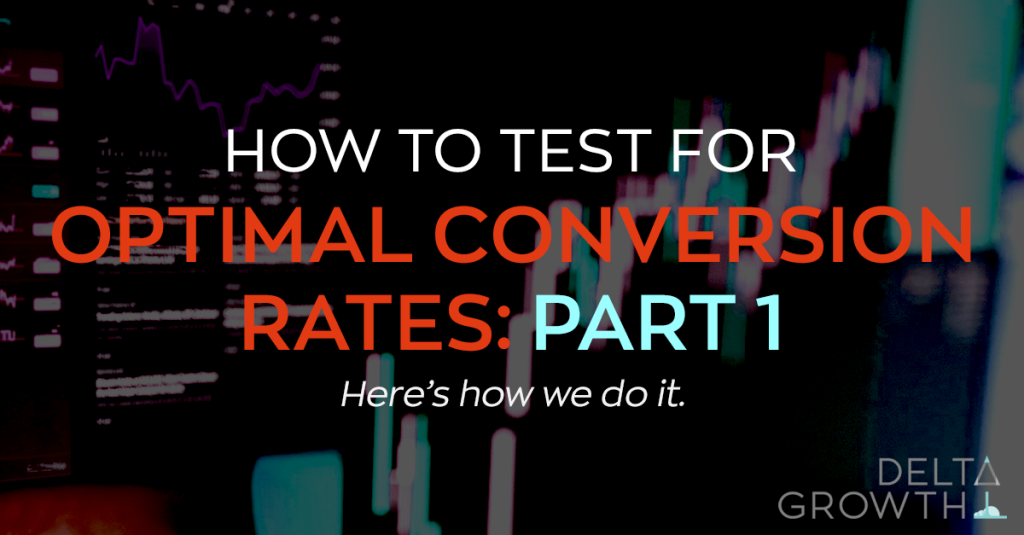
Every click, scroll, and interaction on your website represents a potential conversion opportunity. Yet many businesses leave money on the table by failing to optimize their conversion rates systematically. This is where Conversion Rate Optimization (CRO) A/B testing becomes your secret weapon for maximizing revenue from existing traffic.
At Delta Growth, we’ve seen firsthand how strategic A/B testing can transform underperforming websites into conversion machines. We’ll share some strategies, tools, and methodologies needed to implement effective CRO A/B testing that delivers measurable results.
Understanding the foundation of CRO A/B Testing
CRO A/B testing involves comparing two versions of a webpage or element of a webpage to determine which performs better in terms of conversion rates. Unlike traditional marketing tactics that focus on driving more traffic, CRO maximizes the value of visitors you already have by removing friction and optimizing user experience.
The beauty of A/B testing lies in its scientific approach. Rather than making assumptions about what your audience wants, you let real user behavior data guide your decisions. This data-driven methodology eliminates guesswork and provides concrete evidence for optimization decisions.
Now, let’s break it down step-by-step on how we do things at DG:
1. Set Up Your Testing Framework
Before launching any tests, we establish a robust framework that ensures reliable results. We start by defining clear conversion goals that align with your business objectives – these can include email signups, product purchases, demo requests, or content downloads.
Next, we implement proper tracking mechanisms using tools like Google Analytics 4, Google Tag Manager, or specialized platforms like Hotjar or Mixpanel. Accurate measurement is crucial because even small tracking errors can lead to false conclusions and misguided optimizations.
Statistical significance is another critical foundation element. Your tests need sufficient sample sizes to produce reliable results, typically requiring at least 95% confidence levels before making decisions. Tools like Optimizely or VWO can help calculate required sample sizes and track statistical significance automatically.
2. Identify High-Impact Testing Opportunities
Not all webpage elements deserve equal testing attention. Focusing the effort on high-impact areas that directly influence conversion decisions is key to getting where you want to go. Primary conversion paths, including landing pages, product pages, and checkout flows, typically offer the most significant optimization potential.
Starting with elements that have the highest visibility and interaction rates, like headlines, call-to-action buttons, form fields, and value propositions, often yield significant improvements when optimized. Additionally, analyzing the current conversion funnel to identify pages with high exit rates or low conversion rates – these represent prime testing opportunities.
User feedback and behavioural data can reveal additional testing opportunities. Heat maps, session recordings, and customer surveys often uncover friction points that aren’t immediately obvious from analytics alone.
3. Implement and Scale The Testing Program
Success with CRO A/B testing requires systematic implementation and continuous iteration. We like to start with high-impact, low-complexity tests to build momentum and demonstrate value. Documenting all testing procedures, results, and insights to create a knowledge base for future optimization efforts.
We also create a testing calendar that ensures continuous optimization without overwhelming your team or website visitors and prioritizing tests based on potential impact, implementation complexity, and available resources.
Most importantly, fostering a culture of testing within your organization is essential. When teams understand that optimization is an ongoing process rather than a one-time project, they’re more likely to contribute ideas and support testing initiatives.
4. Measure Long-Term Success
While individual test results are important, we focus on cumulative improvement over time. Track your baseline conversion rates and monitor how systematic testing improves overall performance. The compound effect of multiple successful tests can dramatically transform your conversion rates over months and years.
CRO A/B testing represents one of the most effective ways to maximize your existing traffic’s value. By implementing systematic testing processes, focusing on high-impact elements, and maintaining a commitment to data-driven decision making, we can achieve substantial conversion rate improvements that directly impact your bottom line.
In part II, we will do a deep dive into the essential elements to test and some of the most common mistakes to avoid. In the meantime, if you are ready to transform your conversion rates through strategic
A/B testing? Contact us to learn how our CRO experts can help you implement a testing program that delivers measurable results and sustainable growth.
Answers to Common Questions About CRO
What’s a good conversion rate?
This will vary by industry, but a general benchmark is between 2% and 5% for most websites. High-performing e-commerce sites often achieve 5% or more, while lead generation sites may aim for 10% or more.
How can I calculate my conversion rate?
The formula is quite simple:
(Number of Conversions ÷ Total Visitors) × 100
For example, if 50 people buy from your site out of 2,000 visitors, your conversion rate is 2.5%.
How long should I run an A/B test?
A/B tests should run long enough to gather statistically significant results. This often means at least 1–2 weeks, depending on your traffic volume, but it’s best to wait until you have enough data to be 95% confident in the winner.
Does CRO only apply to websites?
No — CRO can be applied anywhere a conversion happens. This includes email campaigns, ads, mobile apps, landing pages, and even checkout processes. The same testing and optimization principles apply.
How does Delta Growth run CRO experiments?
At Delta Growth, we understand that CRO can significantly change your business by helping you to get the most out of your already existing traffic.
We want to help you convert more of the visitors you already have — improving ROI, lowering acquisition costs, and increasing revenue.



